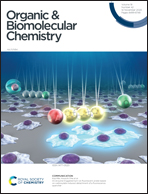Intrinsic fluorescence properties of antimalarial pyrido[1,2-a]benzimidazoles facilitate subcellular accumulation and mechanistic studies in the human malaria parasite Plasmodium falciparum†
Abstract
The intrinsic fluorescence properties of two related pyrido[1,2-a]benzimidazole antimalarial compounds suitable for the cellular imaging of the human malaria parasite Plasmodium falciparum without the need to attach extrinsic fluorophores are described. Although these compounds are structurally related, they have been shown by confocal microscopy to not only accumulate selectively within P. falciparum but to also accumulate differently in the organelles investigated. Localization to the digestive vacuole and nearby neutral lipids was observed for compound 2 which was shown to inhibit hemozoin formation using a cellular fractionation assay indicating that this is a contributing mechanism of action. By contrast, compound 1, which differs from compound 2 by the replacement of the imidazole[1,2-a:4,5-b′]dipyridine core with the benzimidazole core as well as the presence of Cl substituents, shows very different localisation patterns and shows no evidence of hemozoin inhibition, suggesting a different mechanism of antimalarial action. Docking profiles of both compounds on the hemozoin surface further provided insight into their mechanisms of action.
![Graphical abstract: Intrinsic fluorescence properties of antimalarial pyrido[1,2-a]benzimidazoles facilitate subcellular accumulation and mechanistic studies in the human malaria parasite Plasmodium falciparum](/en/Image/Get?imageInfo.ImageType=GA&imageInfo.ImageIdentifier.ManuscriptID=D0OB01730B&imageInfo.ImageIdentifier.Year=2020)
- This article is part of the themed collection: Chemical Biology in OBC


 Please wait while we load your content...
Please wait while we load your content...